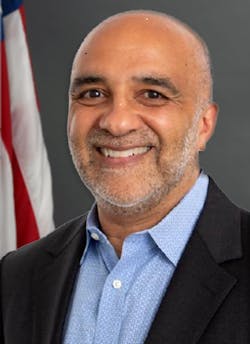Looking at the challenges and opportunities facing HIE leaders going forward, Hagland noted that some statewide HIEs are thriving by connecting themselves to public health reporting, particularly during the COVID-19 pandemic, and by linking to fellow HIEs to provide levels of service not possible on the part of HIEs limited to individual metropolitan areas or smaller regions.
Among the industry leaders whom Hagland interviewed for the article was Micky Tripathi, Ph.D., the National Coordinator for Health IT, who came into his role on January 20, the day on which President Joe Biden was inaugurated. Tripathi, who spent decades as a highly respected leader focusing on issues such as standards and interoperability, praised statewide and statewide-plus organizations such as the Columbia, Maryland-based CRISP and the Indianapolis-based IHIE, which serve Maryland and Indiana—and in the case of CRISP, now also the District of Columbia, Connecticut, and West Virginia. In April, Hagland spoke with Tripathi about the future of HIEs, as well as about his unfolding role at the Office of the National Coordinator for Health IT (ONC). Below are excerpts from Hagland’s April interview with Tripathi.
What has it been like so far, over the past two-plus months as National Coordinator for Health IT?
So far, it’s been fantastic. And the team is a great team, and I know the people well, having worked with the committees, and senior officials over the years. And it would have been quite a challenge had I not been familiar with them, and coming in through Zoom in January. So I’ve been fortunate; and of course, I was familiar with the issues. It’s been really exciting; and a privileged time to be working in this space. Having laid the foundation, through electronic health records in the past ten years, there are things we can do with them now. And also, the opportunity to work with the federal government at this time, in terms of the central role that the fed government can play at this time.
Dr. Tripathi, one of the questions underlying a lot of leaders’ concerns in healthcare has been how federal healthcare policy authorities view the role of HIEs going forward. How do you see HIEs, in the context of all the policy priorities that you and ONC have, around interoperability, improved clinical computing and workflow, and the sharing of key data for public health purposes?
So, as you know, I started off in health IT and in the HIE world; my first engagement in the health IT world was helping to found the Indiana Health Information Exchange. Looking at it now, HIEs are a firm part of the landscape for sure. But it’s a complicated landscape with lots of different plays and regional differences. But in some places in the country, they’re not as prominent. There’s been a lot of growth, a lot of experimentation, a lot of value added back.
Do you see HIEs as having come into their moment, in terms of the pandemic, and the needs of the national healthcare system just now?
We’re a really complicated and diverse country, with all sorts of unique markets and local circumstances. In terms of CRISP and IHIE, those HIEs have shown us what a really strong HIE with a durable foundation, and strong relationship with state government, can do. But so many parts of the country don’t have HIEs like CRISP and IHIE. Where those HIEs have been strong, yes, they have proven themselves in those markets that can support them, and they’re really valuable. But in other parts of the country, they don’t exist, so how you would scale that? That’s the challenge we would face that we’ve been facing for 20 years.
You were in fact the founding president of IHIE years ago, and who then spent a number of years as CEO of the Massachusetts eHealth Collaborative. From your perspective, what are the biggest challenges facing HIEs overall right now?
You’ve just so tremendously much variation. In some markets, like Indiana, they were able to engage the stakeholders early on, to become a core part of the fabric; in other places, not so much. So, nationwide, how do we raise the level of public health capability across the country, a whole ecosystem, rather than some kind of knitting together of pipes? And if you think about EHR [electronic health record] systems being able to integrate and provide information, perhaps in a bidirectional way, with public health and CDC, we’d want that to happen equally in all markets. On the other hand, in certain markets, where you have more full-blown state HIE capabilities, it will be easier to use those entities as conduits perhaps, and for statewide HIEs, you could do more.
In states where that doesn’t exist, what will ONC do, and what might the CDC [Centers for Disease Control and Prevention] do?
I think we’ll just need to raise the level of what we can accomplish, though you can’t force-fit any one model. And a part of the complexity in the US is not just the technological complexity, it’s the people and jurisdictional aspects. In public health, the biggest challenge is the jurisdictional issues; the federal government with the CDC, but then 56-60 state-level and local entities, all with their own policies on what’s shareable and not. Even what’s sent to the CDC is highly variable. Some states won’t send their immunization data to the federal government. So we already live in that world; we can’t simply come through and sweep across and say everyone has to do things at the same level.
Can ONC do something to create some level of uniformity?
We’re working in partnership with the CDC to think about the future of the public health infrastructure we want to have. Clearly, the CDC is the lead in that. But we help them to figure out how to use standards and EHR technology, how to leverage what we’ve spent $40 billion on installing, to support public health—both the information itself, and the functionality—the ability to do bidirectional data-sharing. And if you look at what’s happened during the pandemic, very little of the data has actually come out of EHR systems; if you compare the information coming to public health authorities from EHR systems, versus nationwide networks, from the EHRs, it’s very small.
You’ve also spoken of the importance of alliances in this space. Can you talk a bit about them?
Yes, you’ve got several nationwide networks working to enhance health data exchange: CommonWell, Carequality, EHealthExchange [the Boston-based CommonWell Health Alliance, the Vienna, Va.-based Carequality, and the Vienna, Va.-based EHealthExchange]. And [what can be done in some areas] varies, because the amount of information contained in HIEs may not yet be flowing to public health yet, because of the way in which public health agencies exist today. But there are a lot of places where we can work with HIEs, including through the StarHIE program [the Strengthening the Technical Advancement & Readiness of Public Health via Health Information Exchange Program], to get immunization data, for example—information that isn’t generally available. This is where you’d have flexibility and a unique position in the market, and they could help us to push the envelope on issues, such as the policy issues you’d encounter, when you try to share information, including around some of the anomalies embedded in HIPAA.”
What do you see as the core challenges and opportunities facing the leaders of HIEs in the current healthcare operating landscape? What do the next couple of years look like to you?
One is how they differentiate themselves from just basic commodity exchange. As the nationwide networks continue to grow and build capability, and work hard on TEFCA, the commodity exchange that HIEs built, some of the data exchange they’re involved in become commoditized into HER systems. So how do they fit into the nationwide ecosystem. And some providers will have their own channels into the nationwide ecosystem; in other cases, HIEs can provide the onramp to that ecosystem. So what is the business model, in the face of market change? They’ve got to figure out how to differentiate themselves in the marketplace.
What do you see as the biggest challenges facing HIEs in the next five years?
It is in that core question of how you continue to differentiate yourself and add value? As with lots of activities, figuring out what not to do will be the biggest question. Because they can’t do everything. In general, as you think about—where are the value-added kinds of things that more localized HIEs can’t do. So LTPAC, social services, engaging payers, those are all parts of the local ecosystem that aren’t part of the nationwide network ecosystem, for example. And social services are very local, so that’s one area to think about, versus what’s offered at the nationwide level.
And there’s go broader or higher—so that you’re not just exchanging CCDAs, because that kind of service is all being replaced. So cleaning up the data, providing a longitudinal record, being able to provide semantic analytics, can be differentiating as well; and then, engaging state governments. And one thing that a number of statewide HIEs are doing is building strong relationships with both their state government and with public health; and that’s not something that nationwide networks can do. So I’ve just named a whole bunch of things, which speaks to the issue of figuring out the things I’m really good at and the market wants, and how I bring resources to bear to the market.
Is there anything you’d like to add?
I would just go back to the beginning of this discussion: HIEs are a really important part of the landscape. I think that they should be encouraged, and will hopefully flourish in all sorts of ways. What’s needed are nationwide interoperability networks that provide that type of service; but the bigger challenge is how you scale up to provide services that the market needs and wants.” And that, most certainly will be a subject of ongoing interest, as HIEs move into the future.



